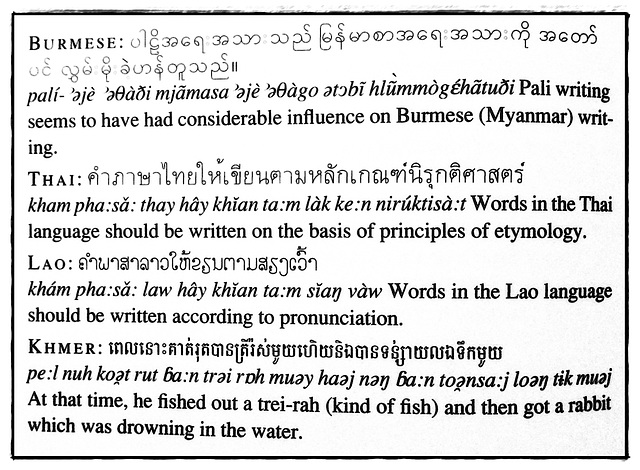TURQUIE
VILLAGE DES MUONG VIETNAM
Purple Weeds
Against the clouds
Rock pool, Cornwall
Buttercups in the bush
Kaka Beak and Leaves
St Ives, Cornwall
RAAG SX150ITU award
In historic homestead, Altona 2
Steam Rising
GSF Celtic Sea in Malta
Greenbank Cove
Rotorua Museum
In Rotorua City
LYON
MARRAKECH MAROC
Tall Ships Race - departure from Lisbon.
H. A. N. W. E. everyone!
HFF Everyone! And a very Happy Easter!
Lake Whakamaru Reflections.
Clouds over Whakamaru.
Bedtime
The Girl Next Door In The Lake
Hemlock
Weeds Are Beautiful Too!
Fly on a Daisy.
Bejeweled Weed
Cascades d'Akchour
Thistles
Growing wild
Heather and gorse; the coast path above Greenbank…
R/V Aegaeo @Piraeus (2017)
Unloved Beauties.
Scotch Thistle.
NOEL
NANTES
Sutherland.
Mute in the Sunset
Grass seed
Thistledown
Penberth Cove
The light before the storm
Here it comes
Keywords
Authorizations, license
-
Visible by: Everyone -
All rights reserved
-
840 visits
South-East Asian scripts of Indian origin


One characteristic of Indian civilisation that they brought with them was a tendency to modify and customize the alphabet. Just as there are now at least ten major scripts derived in India from the Brahmi characters (diffused all over the subcontinent in Ashoka’s time), there are another nine that developed in South-East Asia, Indonesia and the Philippines, all derived from Indian scripts, many through the Pallava script of the south. The origin of of this diversity lies in the variety of writing materials available in different places, but the different styles evidently came to be national icons. In the Cambodian pillars that carry rules for monasteries, Sanskrit in Khmer script on one side is paralled by Sanskrit in a North Indian Script on the other: perhaps there were North Indian devotees as well as Khmers residents here.
This is just one of the many signs that there was heavy cultural traffic in both directions between India and Indo-China during this period. Another example is given by the life of Atisa, a monk born in Bengal in 982, who went on to become one of the founders of Buddhism in Tibet in his sixties. He had spent his student days in Sri Vijaya, in Sumatra. ~ Page 203
Nevertheless, this roll-call of states and civilizations that took their beginnings from India reminds us how vast, how varied and how long lasting this influence was, all the more remarkable because no military force seems to have been applied anywhere to bring in the new, more organized, Indian society. This contrasts sharply with the record of incursions from the other developed civilizations to the north. Ever since the first century AD., China had been putting constant pressure on the Annamite kingdom of northern Vietnam, periodically invading it, and insisting on recognition of China’s emperor as its overlord ~ Page 204
To this day, Hinduism survives on the island of Bali, east of Java. However in South-East Asia the picture is now very different. Hinduism long ago replaced by Buddhism. This is the result of a long and complex though not especially bloody, history of doctrinal contests between the two faiths. Hindu cults’ close associations with ruling dynasties ultimately worked against them, when those dynasties fell. But there was also competition among strains of Buddhism, Tantra, originally “the loom’ or ‘the framework’, Mahayana, ‘the great vehicle’ and ’Theravada, ‘the doctine of the elders.” Theraveda, buttressed by links with the Sinhala in Sri Lanka, ultimately triumphed in South East Asia. Nevertheless, all these struggles took place against an unchallenged background of Indian learning. ~ Page 208
This is just one of the many signs that there was heavy cultural traffic in both directions between India and Indo-China during this period. Another example is given by the life of Atisa, a monk born in Bengal in 982, who went on to become one of the founders of Buddhism in Tibet in his sixties. He had spent his student days in Sri Vijaya, in Sumatra. ~ Page 203
Nevertheless, this roll-call of states and civilizations that took their beginnings from India reminds us how vast, how varied and how long lasting this influence was, all the more remarkable because no military force seems to have been applied anywhere to bring in the new, more organized, Indian society. This contrasts sharply with the record of incursions from the other developed civilizations to the north. Ever since the first century AD., China had been putting constant pressure on the Annamite kingdom of northern Vietnam, periodically invading it, and insisting on recognition of China’s emperor as its overlord ~ Page 204
To this day, Hinduism survives on the island of Bali, east of Java. However in South-East Asia the picture is now very different. Hinduism long ago replaced by Buddhism. This is the result of a long and complex though not especially bloody, history of doctrinal contests between the two faiths. Hindu cults’ close associations with ruling dynasties ultimately worked against them, when those dynasties fell. But there was also competition among strains of Buddhism, Tantra, originally “the loom’ or ‘the framework’, Mahayana, ‘the great vehicle’ and ’Theravada, ‘the doctine of the elders.” Theraveda, buttressed by links with the Sinhala in Sri Lanka, ultimately triumphed in South East Asia. Nevertheless, all these struggles took place against an unchallenged background of Indian learning. ~ Page 208
- Keyboard shortcuts:
Jump to top
RSS feed- Latest comments - Subscribe to the comment feeds of this photo
- ipernity © 2007-2024
- Help & Contact
|
Club news
|
About ipernity
|
History |
ipernity Club & Prices |
Guide of good conduct
Donate | Group guidelines | Privacy policy | Terms of use | Statutes | In memoria -
Facebook
Twitter

Sign-in to write a comment.